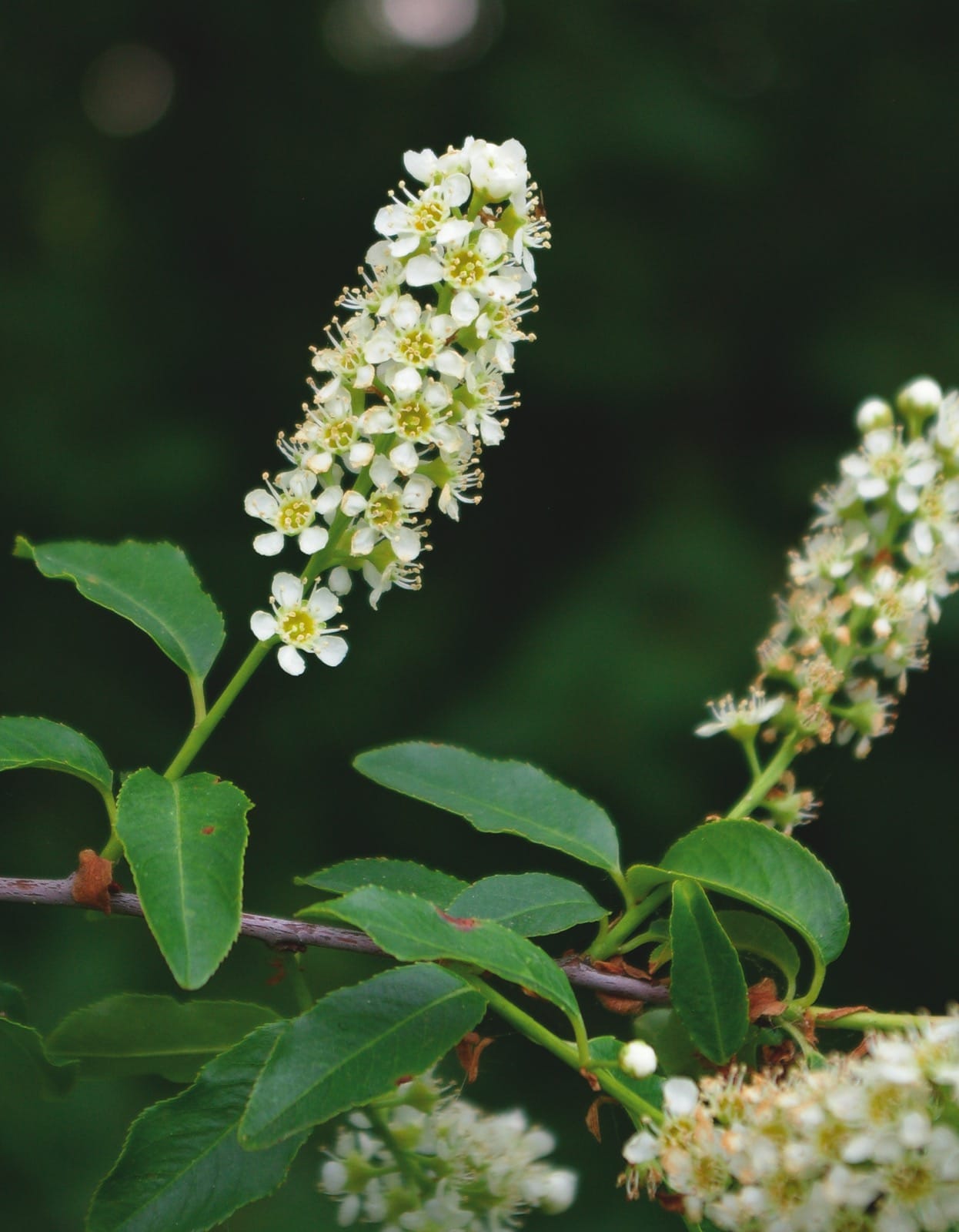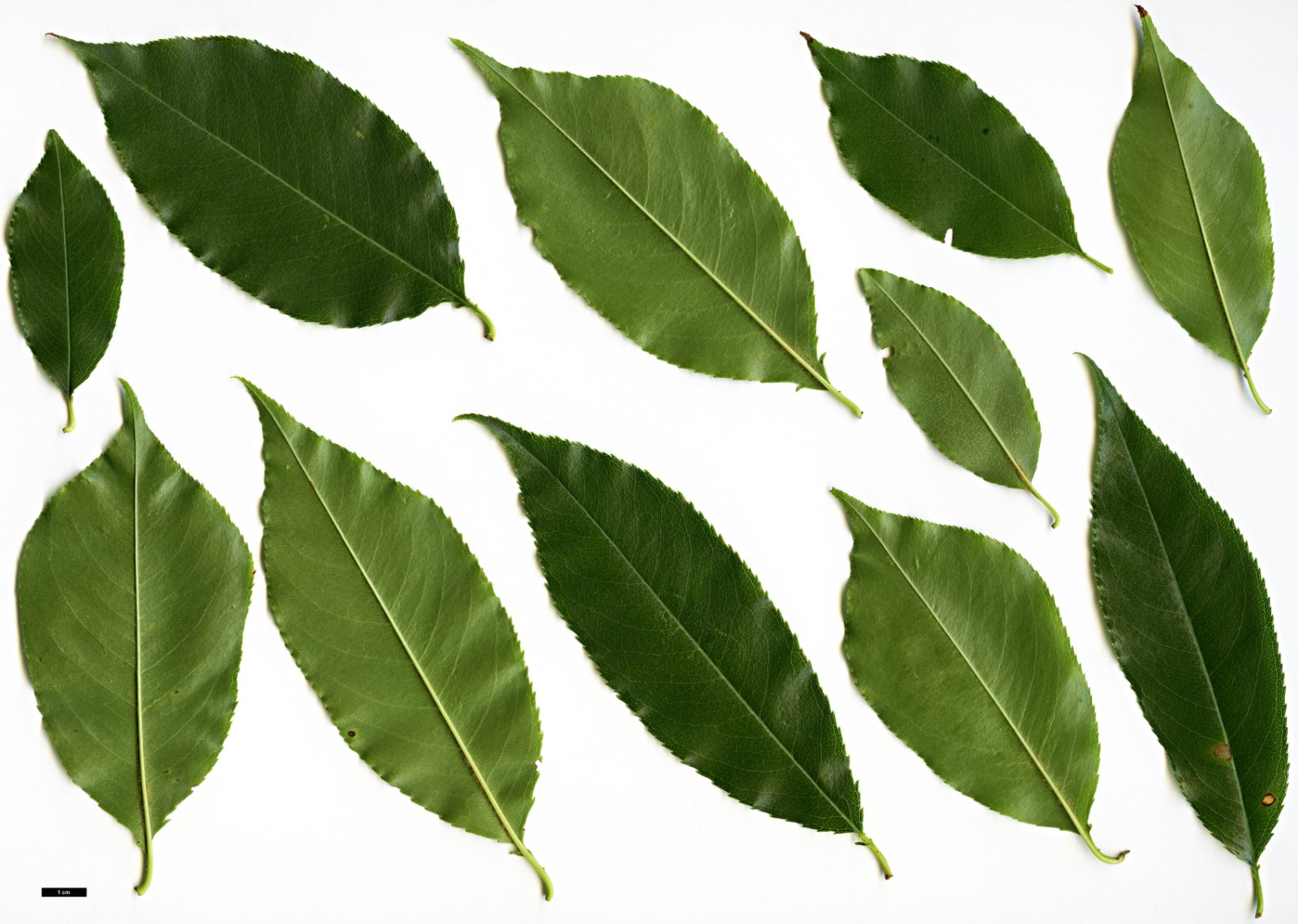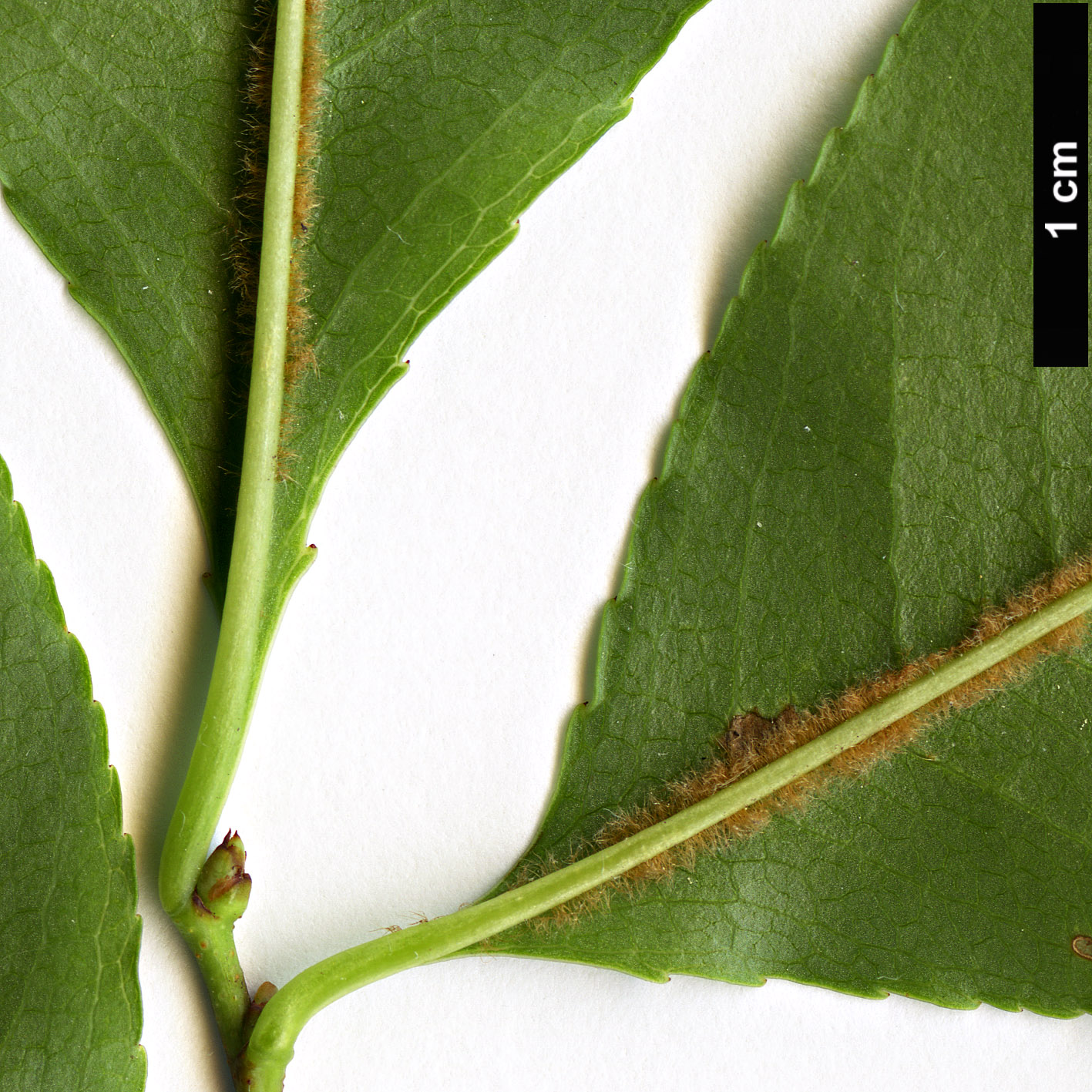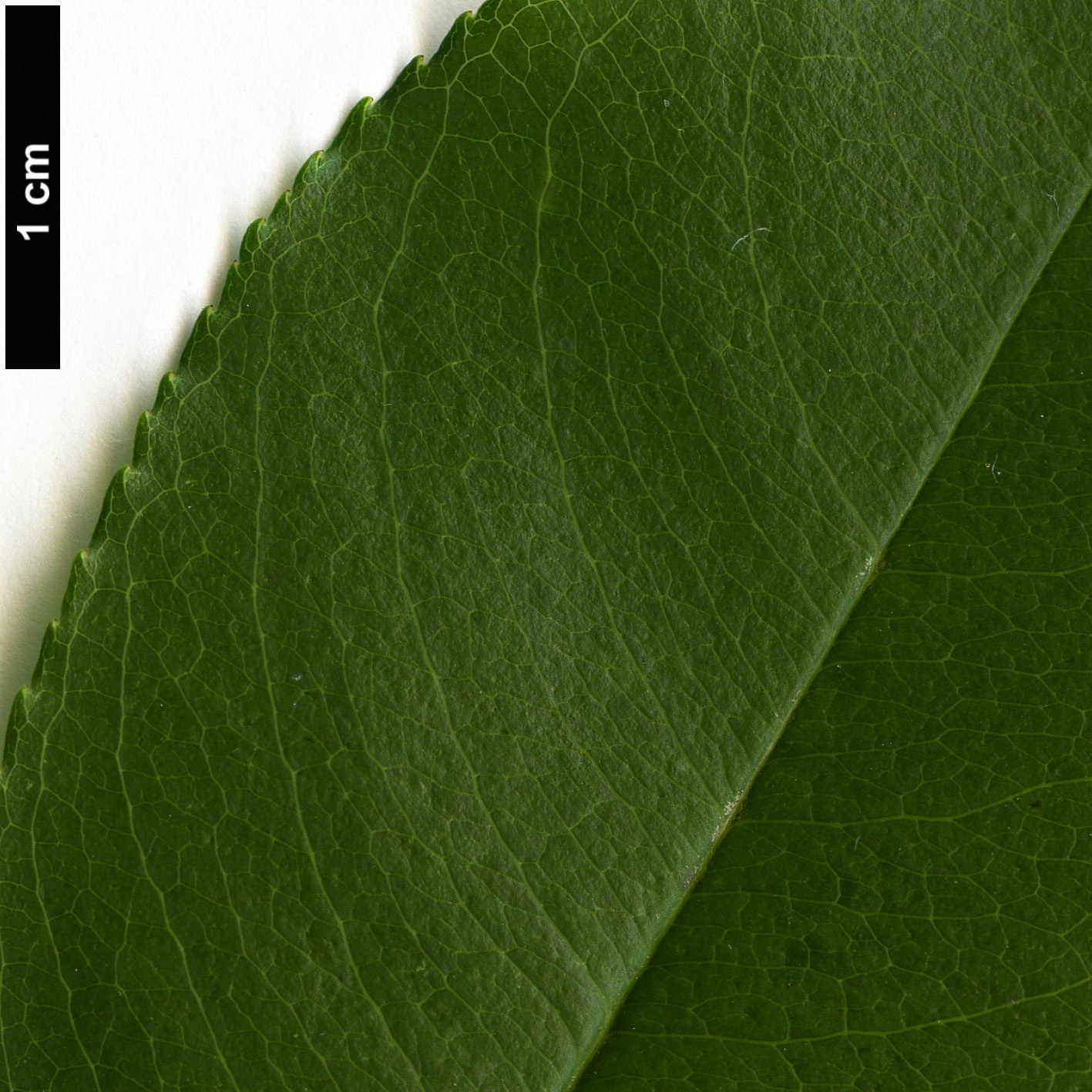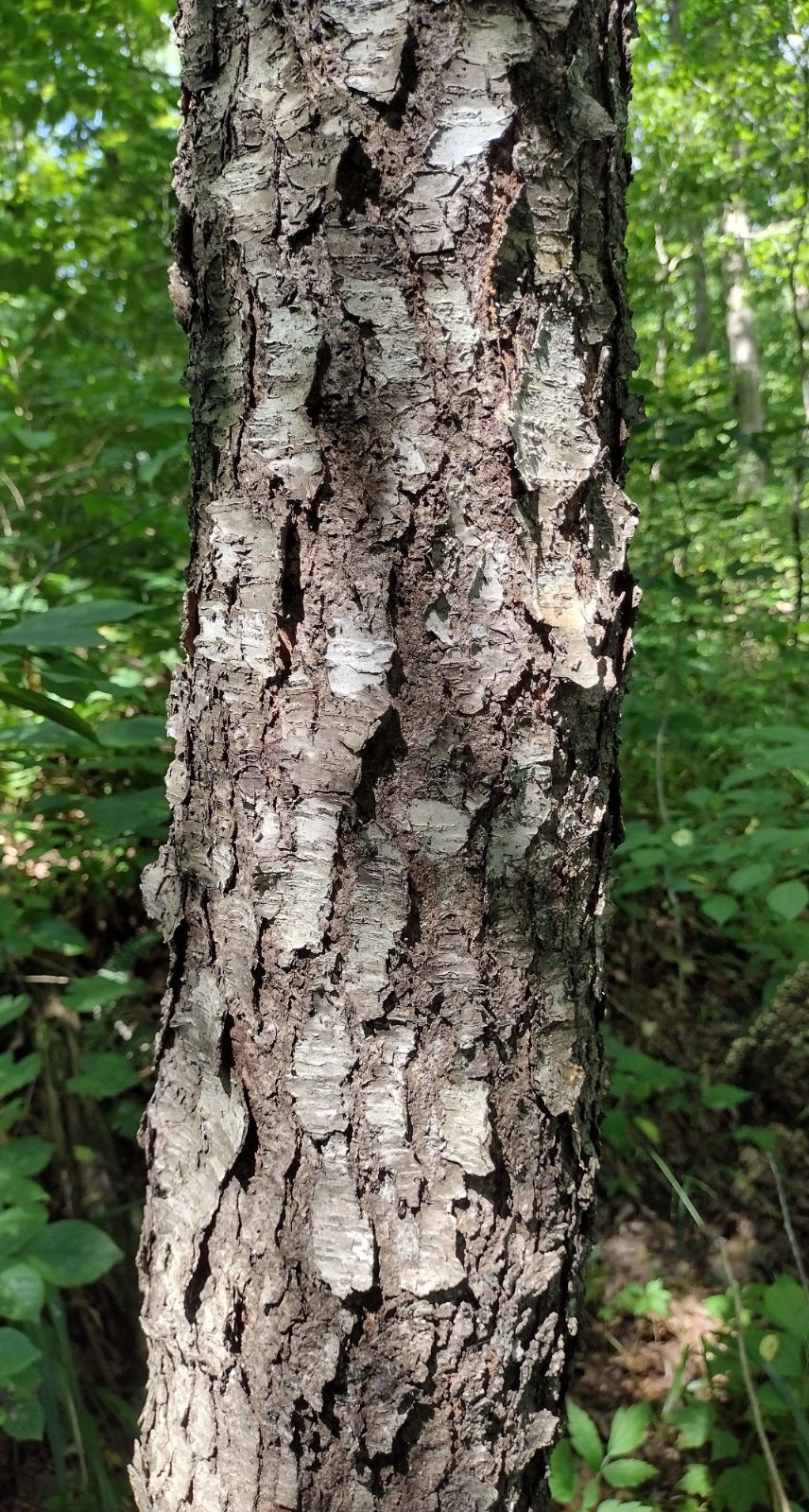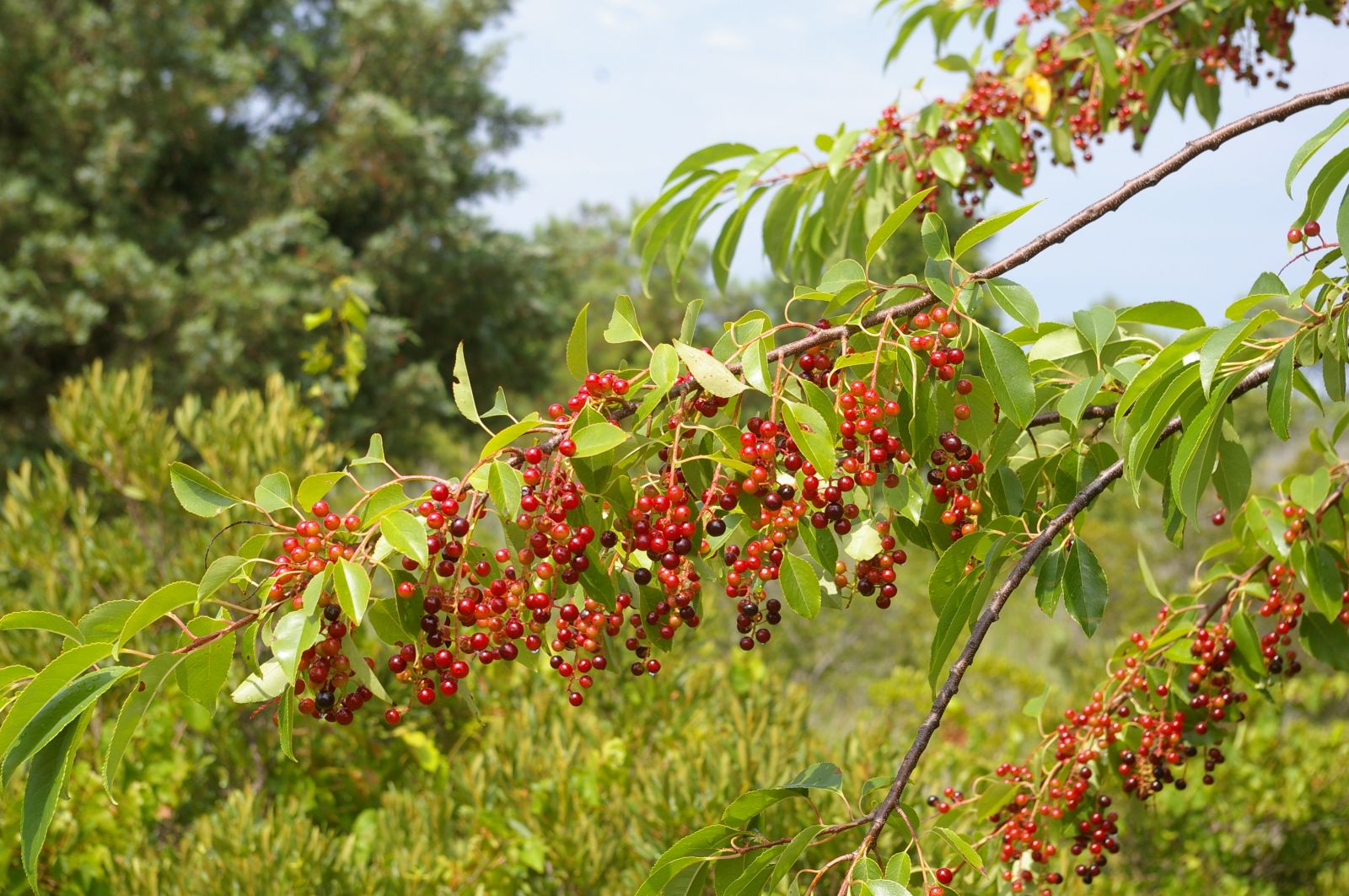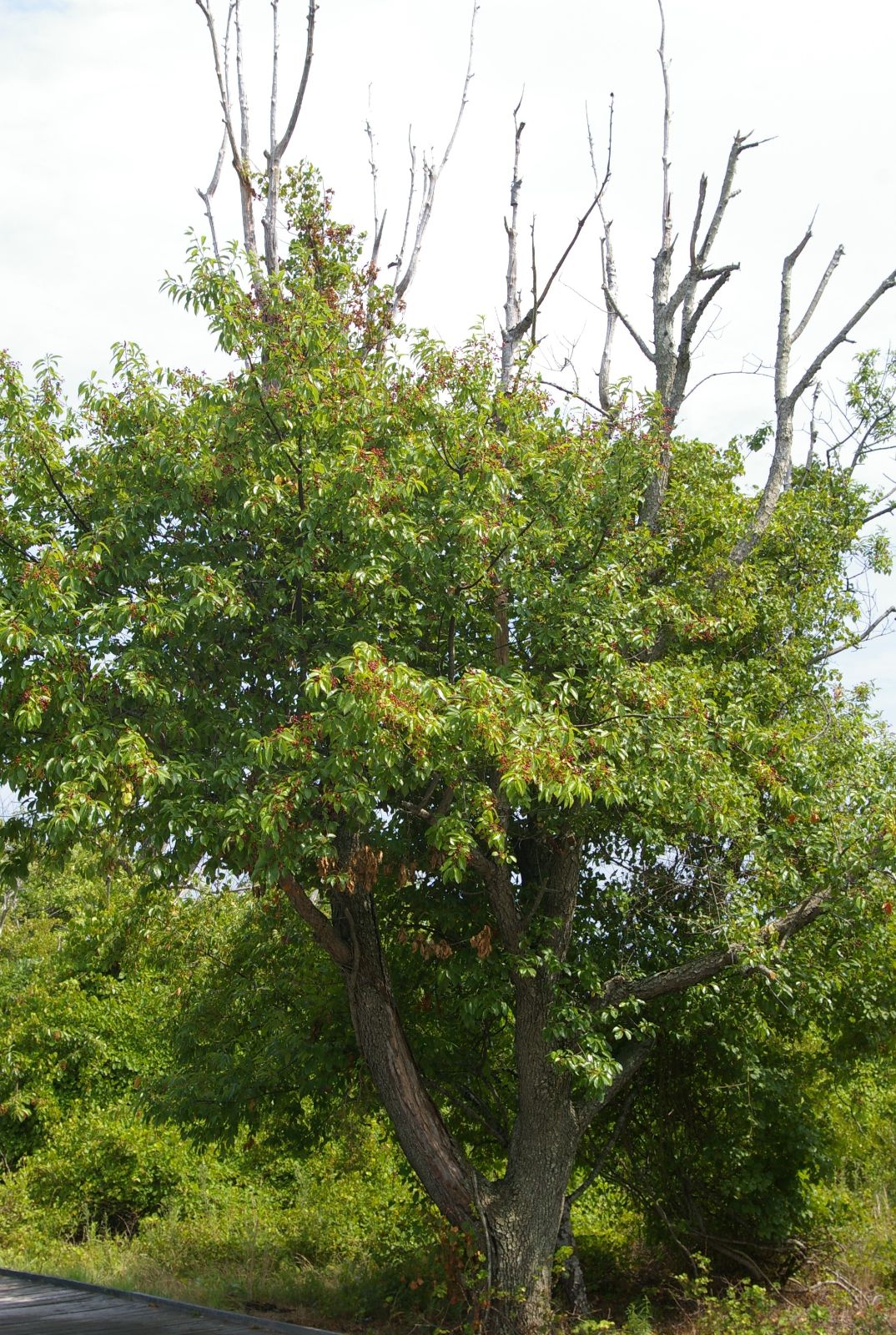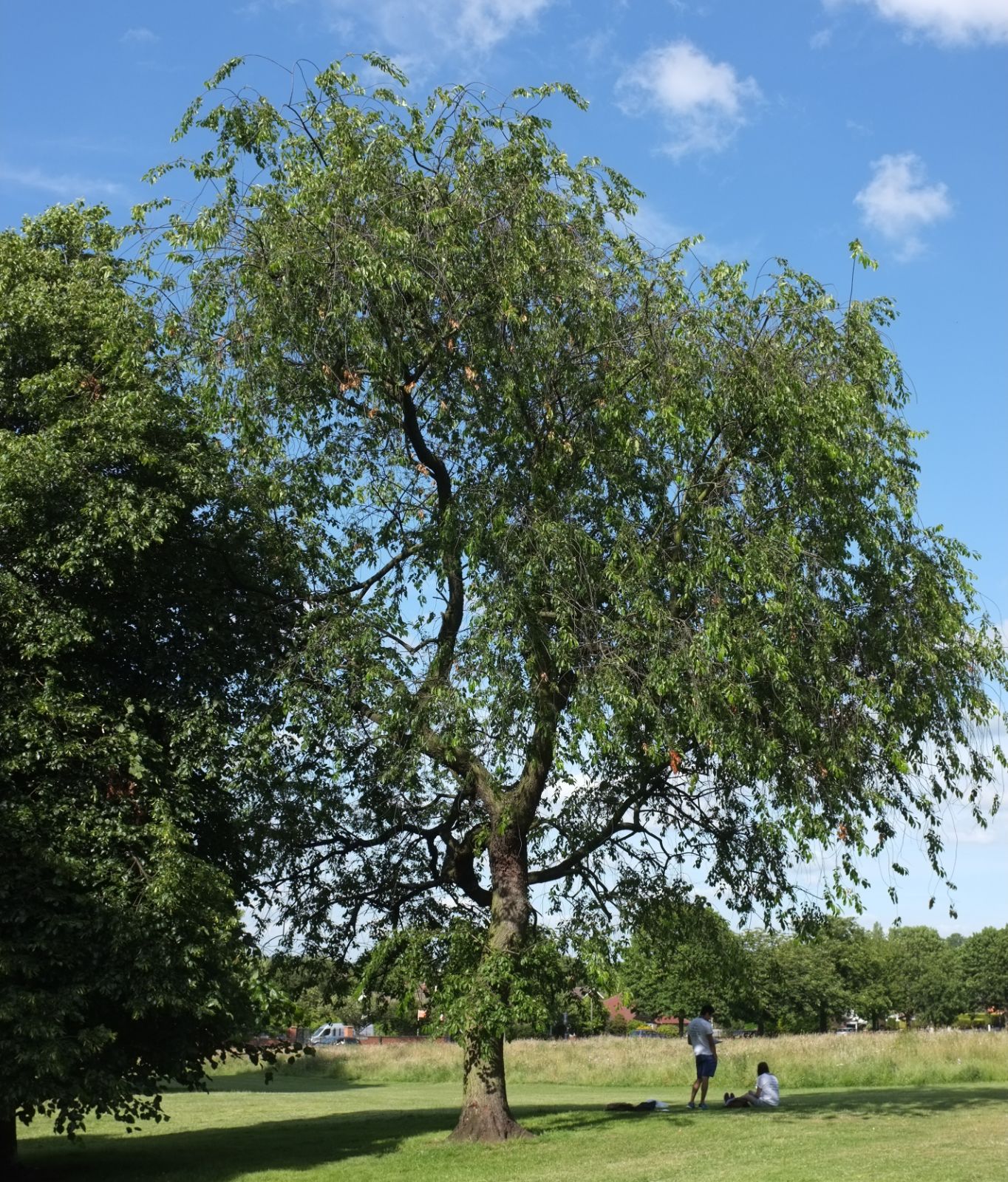Prunus serotina
Credits
Article from Bean's Trees and Shrubs Hardy in the British Isles
Article from New Trees by John Grimshaw & Ross Bayton
Recommended citation
'Prunus serotina' from the website Trees and Shrubs Online (treesandshrubsonline.
Infraspecifics
Other taxa in genus
- Prunus alleghaniensis
- Prunus americana
- Prunus × amygdalo-persica
- Prunus amygdalus
- Prunus angustifolia
- Prunus apetala
- Prunus arabica
- Prunus argentea
- Prunus armeniaca
- Prunus avium
- Prunus besseyi
- Prunus brigantina
- Prunus campanulata
- Prunus canescens
- Prunus cantabrigiensis
- Prunus cerasifera
- Prunus cerasus
- Prunus cocomilia
- Prunus concinna
- Prunus conradinae
- Prunus consociiflora
- Prunus cornuta
- Prunus cuthbertii
- Prunus dasycarpa
- Prunus davidiana
- Prunus × dawyckensis
- Prunus dielsiana
- Prunus domestica
- Prunus dulcis
- Prunus emarginata
- Prunus × fontanesiana
- Prunus fruticosa
- Prunus glandulosa
- Prunus grayana
- Prunus himalaica
- Prunus hortulana
- Prunus humilis
- Prunus ilicifolia
- Prunus incana
- Prunus incisa
- Prunus jacquemontii
- Prunus kansuensis
- Prunus lannesiana
- Prunus laurocerasus
- Prunus litigiosa
- Prunus lusitanica
- Prunus maackii
- Prunus mahaleb
- Prunus maritima
- Prunus maximowiczii
- Prunus microcarpa
- Prunus mira
- Prunus mugus
- Prunus mume
- Prunus nigra
- Prunus nipponica
- Prunus orthosepala
- Prunus padus
- Prunus pensylvanica
- Prunus persica
- Prunus pilosiuscula
- Prunus prostrata
- Prunus pumila
- Prunus rufa
- Prunus salicina
- Prunus sargentii
- Prunus serrula
- Prunus serrulata
- Prunus sibirica
- Prunus × sieboldii
- Prunus simonii
- Prunus sogdiana
- Prunus speciosa
- Prunus spinosa
- Prunus ssiori
- Prunus subcordata
- Prunus subhirtella
- Prunus takesimensis
- Prunus tangutica
- Prunus tenella
- Prunus tomentosa
- Prunus triloba
- Prunus virginiana
- Prunus × yedoensis
A large deciduous tree, reaching in its most favoured situations a height of 80 to 100 ft, and occasionally found with trunks 16 ft in circumference. In England it is usually 30 to 50 ft high, the young bark glabrous, bitter, aromatic, not unpleasant to the taste. Leaves oval-lanceolate, sometimes narrowly obovate, tapering towards both ends, 2 to 51⁄2 in. long, and from 1 to 13⁄4 in. wide, glabrous and shining above, paler beneath, and usually hairy along the midrib, margins set with shallow incurved teeth; stalk 1⁄4 to 1 in. long. Flowers white, 1⁄3 in. in diameter, produced during late May and June in cylindrical racemes 4 to 6 in. long, 3⁄4 in. diameter. Fruits black, 1⁄3 in. across, round, but rather flattened like an orange.
Native of N. America, where it is widely spread, reaching from Nova Scotia to Florida, and westwards to Dakota, Texas, Arizona, etc. At its finest, which is in the Allegheny Mountains of Virginia, it is probably the largest of the genus. In Great Britain it thrives very well, and makes a handsome middle-sized tree of graceful habit, whose dark glittering foliage in summer very much resembles that of a Portugal laurel, but it is of course deciduous, and dies off a pleasing yellow. The flowers are borne profusely, and some trees ripen abundant fruits; in the United States the latter are used for flavouring rum and brandy, and for that purpose are said to be equal to the Morello cherry. I am not aware that this tree has been tried under forest conditions here, but its timber is much valued by cabinet-makers, and judging by its behaviour at Kew it will thrive better than many trees on sandy ground. The largest specimen there is 65 ft high, with a trunk 61⁄4 ft in girth (1967).
Other specimens recorded recently are: Tubney Wood, Oxon., two specimens pl. 1906, 70 × 4 ft and 60 × 41⁄4 ft (1906); Westonbirt, Glos., 60 × 51⁄2 ft (1968); Hewell Grange, Worcs., 68 × 7 ft (1963); Arley Castle, Worcs., 70 × 41⁄2 ft (1966).
From New Trees
Prunus serotina Ehrh.
American Black Cherry
This well-known and valuable species was described by Bean (B396) and Krüssmann (K46), but several local variants are now treated at subspecific level and may be found in some collections. A key to all the subspecies of Prunus serotina, modified from that of McVaugh (1951), is provided below.
| 1a. | Branchlets and foliage entirely glabrous, leaves coarsely serrate, petiole long (~1.5 cm); USA (Texas: Edwards Plateau) (not traced in cultivation) | subsp. eximia |
| 1b. | Branchlets glabrous to hirsute, foliage rufous-pubescent below, leaves finely serrate, petiole short (< 1 cm) | 2 |
| 2a. | Branchlets rufous-hirsute; leaves not or scarcely drooping, less than twice as long as wide, lower surface uniformly pubescent; USA (Alabama, Florida, Georgia) | subsp. hirsuta |
| 2b. | Branchlets glabrous or sparsely hirsute; leaves drooping, 2.5–3 times as long as wide, lower surface glabrous except for tufts of hair near base of midrib | 3 |
| 3a. | Branchlets glabrous; leaves narrowly lanceolate, usually 8–12 cm long and 2.5–3.5 times as long as wide, sometimes totally glabrous; racemes > 15 cm long; fruit to 2–2.5 cm diameter; USA (California), Mexico (southern), Central America, South America | subsp. capuli |
| 3b. | Branchlets glabrous or sparsely hirsute; leaves elliptic to ovate, usually 1.8–2.5 times as long as wide; racemes < 15 cm long; fruit to 0.6–1 cm diameter | 4 |
| 4a. | Xerophytic growth-form with small leaves, sparse branches; leaves 5–7(–9) cm long; racemes ~10 cm long; USA (Arizona, New Mexico, Texas), Mexico | subsp. virens |
| 4b. | Mesophytic growth-form with large leaves, luxuriant growth; leaves 6–9(–15) cm long; racemes ~12 cm long; Canada, USA (eastern), high mountains of Mexico & Guatemala | subsp. serotina |
'Asplenifolia'
Leaves deeply and irregularly cut at the margins.f. phelloides Schwer.
Synonyms
P. serotina var. salicifolia Nichols, ex Henry, not (Kunth) Koehne
P salicifolia Kunth
Synonyms
P. serotina var. salicifolia (Kunth) Koehne
P. capuli Cav.
P. capollin Zucc
'Pendula'
A pretty tree with weeping branches, usually budded on tall stems of P. padus.
subsp. capuli (Cav.) McVaugh
Common Names
Capulín
Synonyms
P. salicifolia Kunth
Large-fruited bird-cherry with long, willow-like leaves; inflorescences 15 cm long or more (with ~35 flowers). Specimens from South America are relatively uniform, but the morphology of those from Mexico and Central America can be variable, and hybridisation with other subspecies of P. serotina may be the cause. McVaugh 1951. Distribution BOLIVIA; COLOMBIA; ECUADOR; GUATEMALA; MEXICO: Guanajuato, Hidalgo, Jalisco, México, Michoacán, Querétaro; PERU; USA: California; VENEZUELA. Subsp. capuli is thought to have been indigenous to the highlands of southern Mexico and Guatemala, later introduced to South America and California. Habitat Woods, pastures, hedges, roadsides. Often found in disturbed areas. USDA Hardiness Zone 6–7. Conservation status Not evaluated. Cross-references B397, K45 (in both cases as P. salicifolia).
Subsp. capuli is notable for the size of its fruits, up to 1.7 cm in diameter (Krüssmann 1986), which are produced on long pendulous racemes and look extremely tempting. They are indeed edible, and very highly prized by local people throughout its range in Central and South America: the Capulín’s native range has been blurred by its cultivation as a fruit tree (Office of International Affairs 1989). It seems to be rare in cultivation in our area – surprisingly, given that it is distinctly ornamental in fruit, and hardy in British and western European conditions. It is capable of achieving impressive stature: a specimen of 17 m (in 1981) formerly grew at Kew, but the current British champion, at Greenways, Devon, was measured at 20 m (85 cm dbh) by Owen Johnson in 2004 (TROBI). It is occasionally grown in continental Europe (Jan De Langhe, pers. comm. 2008), and is also in cultivation in California.
subsp. hirsuta (Elliott) McVaugh
Synonyms
P. alabamensis Mohr
P. cuthbertii Small
Subsp. hirsuta is readily distinguished from all other subspecies of P. serotina by the combination of stiffly spreading leaves and racemes, broad-obovate leaves, usually with uniform pubescence on the underside but sometimes hairy only on the midrib, and hirsute branchlets. McVaugh 1951. Distribution USA: Alabama, Florida, Georgia. Habitat Sandy soils, with Pinus palustris and Quercus marilandica. USDA Hardiness Zone 7. Conservation status Not evaluated. Cross-reference K20 (as P. alabamensis).
Prunus serotina subsp. hirsuta is probably better known as P. alabamensis, and this is the name under which it is usually found in collections. It is a vigorously growing tree and is capable of becoming quite large. The British champion is a specimen of 17.6 m (with two stems, of 31 cm and 34 cm dbh) at the Hillier Gardens, planted prior to 1977, and another individual in that collection, accessioned in 1983, was 10.5 m tall in 2004. At Kew a specimen received in 1965 is now 10 m tall by about the same wide. This was just beginning to turn yellow when seen in early November 2007 – rather later than most other trees in that exceptional autumn.
subsp. virens (Wooton & Standl.) McVaugh
Synonyms
Padus virens Wooton & Standl.
Subsp. virens is typical of arid regions and consequently has small leaves, 5–7(–9) cm long, and a rather sparse growth habit. McVaugh 1951. Distribution MEXICO: Chihuahua, Coahuila, Guanajuato, Jalisco, Nuevo León, San Luis Potosí, Sonora; USA: Arizona, New Mexico, Texas. Habitat Wooded valleys in arid and semi-arid mountains, above 1500 m asl. USDA Hardiness Zone 6. Conservation status Not evaluated. Illustration NT663. Cross-reference K56. Taxonomic note Typical subsp. virens is largely glabrous; specimens with thick rufous or grey pubescence on the branchlets and/or inflorescence axes are recognised as subsp. virens var. rufula (Wooton & Standl.) McVaugh.
Subsp. virens is the dryland representative of the Prunus serotina complex, and in most of our area is probably of interest only to collectors. In semi-arid regions of the southern and western United States it might be useful. A tree derived from a collection by Carl English in the Black Mountains of New Mexico has grown at Kew since 1970, reaching about 5 m, but is currently suffering greatly from dieback. The foliage and inflorescences are distinctly smaller than in other forms of P. serotina growing nearby.

